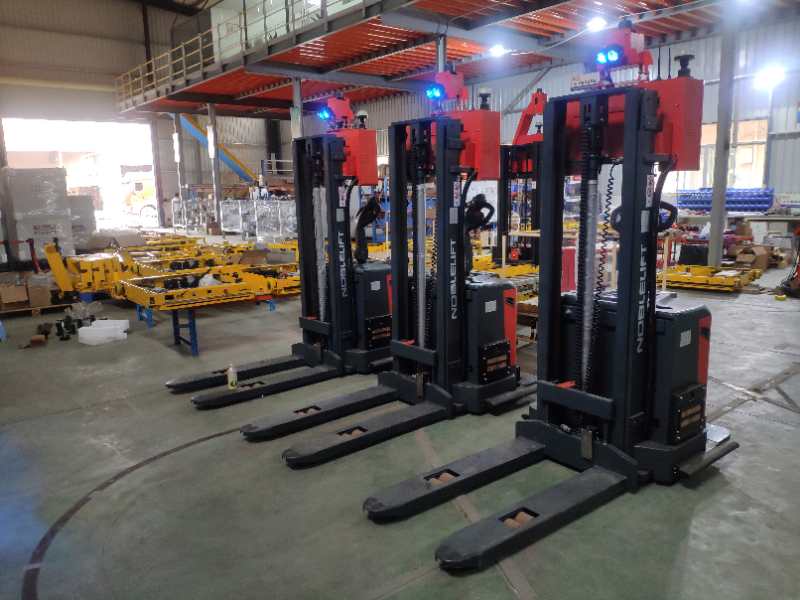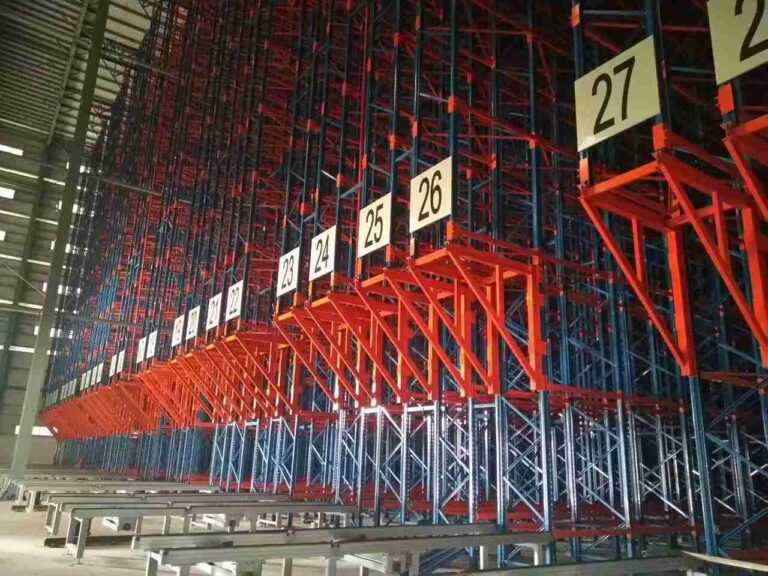📐 "First 50 Enterprise Queries Get Custom 3D Warehouse Design" Plan

Introduction: The Rise of Forklift AGVs in Industrial Automation
The material handling industry is undergoing a seismic shift with the rapid adoption of Forklift AGVs (Automated Guided Vehicles). These intelligent, self-navigating forklifts are transforming warehouses, manufacturing plants, and distribution centers by eliminating manual labor bottlenecks, reducing operational costs, and enhancing workplace safety.
Unlike traditional forklifts that require human operators, Forklift AGVs operate autonomously using AI-driven navigation, LiDAR sensors, and real-time data integration with Warehouse Management Systems (WMS). Businesses leveraging Forklift AGVs report 30-50% improvements in productivity, 20-40% reductions in labor costs, and near-zero workplace accidents—making them a must-have in Industry 4.0 logistics.
This comprehensive guide explores:
✔ How Forklift AGVs work—breaking down their navigation, sensors, and AI capabilities
✔ Key advantages over manual forklifts—cost savings, efficiency, and safety
✔ Different types of Forklift AGVs—from pallet movers to high-reach models
✔ Top industrial applications—warehousing, manufacturing, cold storage, and e-commerce
✔ How to select the right Forklift AGV—matching specs to operational needs
✔ Future advancements—AI, 5G connectivity, and swarm robotics
For warehouse managers, supply chain directors, and automation engineers, this guide provides actionable insights to determine whether Forklift AGVs are the right investment for your facility.

1. What Are Forklift AGVs? (The Brains Behind Autonomous Material Handling)
Forklift AGVs (Automated Guided Vehicle Forklifts) are driverless robotic forklifts engineered to transport, lift, and position pallets, raw materials, and finished goods without human intervention. They combine cutting-edge automation, machine learning, and industrial IoT to execute tasks with pinpoint accuracy, 24/7 reliability, and zero fatigue.
1.1 How Forklift AGVs Operate: The Technology Stack
A Forklift AGV relies on four core technological pillars:
1.1.1 Navigation Systems (The “Brain”)
- Laser Guidance (LiDAR): Scans surroundings to create real-time 3D maps
- Magnetic Tape/QR Codes: Follows pre-marked paths in structured environments
- Vision-Based Navigation: Uses cameras and AI to recognize racks, pallets, and obstacles
- Inertial Navigation: Gyroscopes and accelerometers for precision movement
1.1.2 Sensors & Safety Mechanisms (The “Eyes”)
- Collision Avoidance: Ultrasonic and infrared sensors detect humans and obstacles
- Load Detection: Weight sensors ensure proper lifting and balance
- Emergency Stop: Instant braking if an obstruction is detected
1.1.3 AI & Machine Learning (The “Decision-Maker”)
- Route Optimization: Dynamically adjusts paths to avoid congestion
- Predictive Maintenance: Alerts technicians before mechanical failures occur
- Adaptive Learning: Improves efficiency by analyzing past operations
1.1.4 Control Software (The “Nervous System”)
- WMS/ERP Integration: Syncs with SAP, Oracle, or Manhattan WMS for real-time task allocation
- Fleet Management: Coordinates multiple Forklift AGVs simultaneously
1.2 Key Tasks Performed by Forklift AGVs
✅ Automated Pallet Transport – Moves goods from receiving to storage
✅ Cross-Docking Operations – Transfers shipments between trucks without storage
✅ Just-in-Time (JIT) Delivery – Supplies assembly lines with precision timing
✅ High-Density Storage Handling – Retrieves pallets from narrow aisles
✅ Cold Chain Logistics – Operates in sub-zero environments without human risk
2. Why Forklift AGVs Outperform Traditional Forklifts (The Business Case for Automation)
2.1 Unmatched Efficiency & Productivity
- 24/7 Operation: No shift changes, breaks, or downtime
- Speed Consistency: Maintains optimal travel speeds without fatigue
- Multi-Shift Capability: One Forklift AGV can replace 2-3 human operators
2.2 Enhanced Workplace Safety
- Zero Operator Error: Eliminates accidents caused by fatigue or distraction
- Collision-Free Movement: Sensors detect obstacles within 360 degrees
- Strict OSHA Compliance: Reduces liability and insurance costs
2.3 Significant Cost Reductions
- Labor Savings: Reduces dependency on $45,000+/year forklift operators
- Lower Maintenance Costs: Electric motors last longer than combustion engines
- Reduced Product Damage: AI ensures gentle handling of fragile goods
2.4 Scalability & Flexibility
- Easy Reprogramming: Adjust routes in minutes via software
- Modular Upgrades: Add new sensors or AI features as needed
- Seamless Integration: Works with existing WMS, ERP, and robotics systems
3. Types of Forklift AGVs (Choosing the Right Model for Your Needs)
| Type | Best For | Load Capacity | Key Feature |
|---|---|---|---|
| Unit Load AGVs | High-volume pallet movement | 1,000–3,000 kg | Single-pallet focus |
| Counterbalanced AGVs | Heavy industrial loads | 5,000–10,000 kg | Mimics traditional forklifts |
| Reach Truck AGVs | Narrow-aisle, high-rack storage | 1,500–2,500 kg | Extendable forks |
| Pallet Truck AGVs | Retail & e-commerce fulfillment | 500–1,500 kg | Compact, low-profile |
4. Industries Transformed by Forklift AGVs
4.1 Warehousing & 3PL Logistics
- Amazon, DHL, and FedEx use Forklift AGVs for same-day order fulfillment
- Automated Storage & Retrieval Systems (AS/RS) integration
4.2 Automotive & Aerospace Manufacturing
- Toyota, Boeing, and Tesla deploy Forklift AGVs for JIT parts delivery
4.3 Pharmaceutical & Cold Storage
- -30°C freezer warehouses operated entirely by Forklift AGVs
4.4 E-Commerce Fulfillment Centers
- Walmart, Target, and Alibaba rely on Forklift AGVs for peak season scalability
5. How to Select the Right Forklift AGV (A Buyer’s Checklist)
🔹 Step 1: Assess load capacity (1-ton vs. 10-ton needs)
🔹 Step 2: Choose navigation type (LiDAR for dynamic environments vs. magnetic tape for fixed paths)
🔹 Step 3: Verify battery life (8-hour vs. 24-hour models)
🔹 Step 4: Ensure WMS/ERP compatibility (SAP, Oracle, etc.)
🔹 Step 5: Evaluate after-sales support (maintenance contracts, software updates)
6. The Future of Forklift AGVs (What’s Next in Automation?)
🔮 AI-Powered Swarm Robotics: Fleets of Forklift AGVs collaborating like ants
🔮 5G-Enabled Real-Time Tracking: Sub-millisecond latency for ultra-precise control
🔮 Autonomous Charging Stations: Self-docking when batteries run low
🔮 Predictive Analytics: AI forecasts peak demand periods and adjusts fleet size
Conclusion: Are Forklift AGVs Right for Your Business?
Forklift AGVs are no longer a luxury—they’re a competitive necessity for warehouses and factories aiming to cut costs, boost efficiency, and future-proof operations.
For businesses evaluating automation, the key questions are:
- What’s your current forklift labor cost?
- How much downtime do manual operations cause?
- Could 24/7 autonomous pallet movement accelerate throughput?
If the answer is ”Yes,” then Forklift AGVs are the next logical investment.
FAQs About Forklift AGVs
1. How much does a Forklift AGV cost?
Prices range from 200,000, depending on load capacity and features.
2. Can Forklift AGVs replace all manual forklifts?
Not always—some specialized lifts still require human operators.
3. What’s the lifespan of a Forklift AGV?
7-10 years, with proper maintenance.
4. Do Forklift AGVs require infrastructure changes?
Most work on existing warehouse floors, but LiDAR models need reflective markers.
5. How long does deployment take?
4-12 weeks, depending on fleet size and WMS integration.




